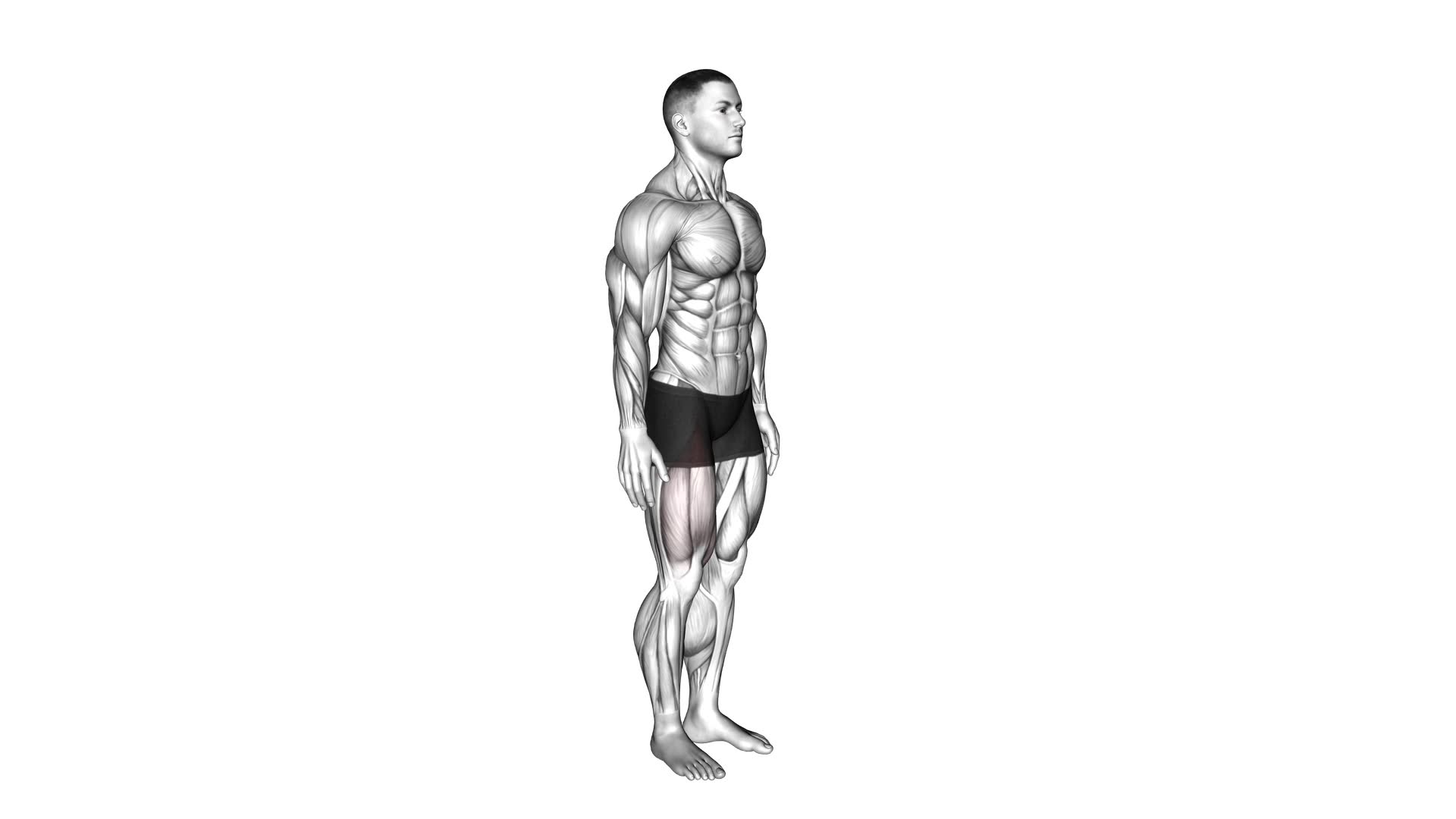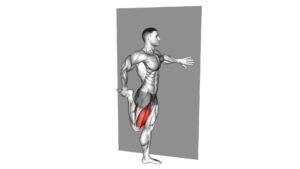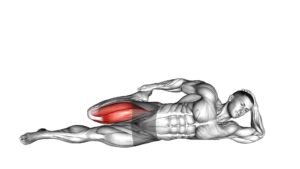Standing Balance Quadriceps Stretch – Video Exercise Guide & Tips

Are you looking to improve your balance and stretch your quadriceps?
Watch This Exercise Video
Then the Standing Balance Quadriceps Stretch is the perfect exercise for you.
This video exercise guide provides step-by-step instructions and tips to help you properly perform this stretch.
Learn about the benefits, common mistakes to avoid, and modifications for different fitness levels.
By incorporating this stretch into your fitness routine, you can enhance flexibility and strengthen your quads.
Get ready to take your fitness to the next level.
Key Takeaways
- Improves balance and coordination
- Strengthens quadriceps muscles
- Increases flexibility and range of motion
- Helps prevent injuries
Benefits of the Standing Balance Quadriceps Stretch
By performing the standing balance quadriceps stretch, you can improve your balance and strengthen your quadriceps muscles. This stretch specifically targets the quadriceps, which are the muscles located on the front of your thighs. The standing balance quadriceps stretch is a versatile and effective exercise that offers several modifications to suit different fitness levels and needs.
One of the main benefits of the standing balance quadriceps stretch is improved balance. As you stretch your quadriceps, you engage the muscles responsible for maintaining stability and equilibrium. This can help you enhance your balance and coordination, which is especially important for activities that require agility and stability, such as walking, running, and sports.
In addition to balance improvement, the standing balance quadriceps stretch also strengthens your quadriceps muscles. As you hold the stretch, you're actively engaging and lengthening these muscles. Over time, this can lead to increased strength and endurance in your quadriceps, allowing you to perform daily activities with greater ease and efficiency.
Furthermore, stretching in general offers numerous benefits for the body. Stretching increases flexibility, improves range of motion, and helps prevent injuries. It can also alleviate muscle tension and soreness, promote blood circulation, and enhance overall physical performance.
Proper Form and Technique for the Stretch
To properly perform the standing balance quadriceps stretch, position yourself near a sturdy support and follow these steps.
Start by standing tall with your feet hip-width apart and engaging your core muscles. Use one hand to hold onto a sturdy object, such as a wall or chair, for balance.
Bend your right knee and bring your right heel towards your glutes, grabbing your right foot with your right hand. Keep your knees close together and your torso upright throughout the stretch.
Gently pull your right foot towards your glutes until you feel a stretch in the front of your right thigh. Hold this position for 20 to 30 seconds, ensuring that you maintain your balance and avoid leaning forward or to the side. Repeat on the other side.
When performing the standing balance quadriceps stretch, it's important to be aware of common errors.
One common mistake is leaning forward or to the side, which can compromise your balance and limit the effectiveness of the stretch.
Another error isn't engaging your core muscles, which can lead to instability and make it difficult to maintain proper form.
Additionally, avoid pulling your foot too forcefully towards your glutes, as this can strain the knee joint.
For those looking to challenge themselves, there are advanced variations of the standing balance quadriceps stretch.
One variation is to perform the stretch without holding onto any support, relying solely on your balance.
Another option is to incorporate a balance challenge by standing on a foam pad or unstable surface while performing the stretch.
These variations help to further improve balance and stability while stretching the quadriceps muscles.
Common Mistakes to Avoid
When performing the standing balance quadriceps stretch, it's important to avoid common mistakes that can hinder your progress.
One common mistake is improper knee alignment, where the knee might twist or buckle inward, putting unnecessary strain on the joint.
Another mistake to avoid is neglecting stability training, as this exercise requires balance and control.
Improper Knee Alignment
One common mistake to avoid when performing the Standing Balance Quadriceps Stretch is letting your knees collapse inward. This improper knee alignment can lead to knee pain and hinder the effectiveness of the exercise. When your knees collapse inward, it puts excessive stress on the knee joint, potentially causing discomfort or injury.
To prevent this, focus on maintaining proper alignment by keeping your knees in line with your toes throughout the stretch. Engage your quadriceps muscles to stabilize your knees and maintain a straight line from your hips to your ankles. By avoiding this common mistake, you can ensure that you're effectively targeting your quadriceps and minimizing the risk of knee pain.
Now, let's transition into the subsequent section about the importance of stability training.
Lack of Stability Training
Improve your stability training by incorporating balance exercises into your routine.
Lack of stability training is a common mistake that can hinder your progress in achieving overall fitness. Stability exercises are crucial for developing a strong core, improving coordination, and preventing injuries.
By neglecting balance training, you're missing out on an opportunity to enhance your overall physical performance. Balance exercises challenge your muscles and joints to work together, improving your body's ability to maintain stability in various positions and movements.
Incorporating exercises such as single-leg stands, stability ball exercises, and yoga poses like tree pose can help improve your balance and stability.
Don't overlook the importance of stability training in your fitness regimen. Take the time to incorporate these exercises into your routine to enhance your overall strength and stability.
Modifications and Variations for Different Fitness Levels
To modify and vary the Standing Balance Quadriceps Stretch for different fitness levels, you can incorporate alternative props and adjust the duration of the exercise. If you're a beginner or have limited flexibility, using a chair or wall for support can help you maintain balance while performing the stretch. Simply hold onto the back of a chair or place your hand against a wall for stability. This modification allows you to focus on the stretch without worrying about losing your balance.
On the other hand, if you're more advanced and looking for a challenge, you can try incorporating different equipment such as resistance bands or ankle weights. These props add resistance, making the stretch more intense and engaging the quadriceps muscles even further.
Additionally, you can adjust the duration of the exercise based on your fitness level. Beginners may start with holding the stretch for 15-30 seconds on each leg and gradually increase the time as they become more comfortable. Intermediate and advanced individuals can aim for longer hold times, such as 45-60 seconds, to further enhance the stretch and promote flexibility.
Tips for Getting the Most Out of the Stretch
To maximize the benefits of the Standing Balance Quadriceps Stretch, focus on maintaining proper form and engaging the core for stability while performing the exercise. This will ensure that you're effectively stretching your quadriceps and gaining the most from this stretch.
Here are three tips to help you get the most out of this exercise:
- Keep your spine aligned: Stand tall with your feet hip-width apart and your shoulders relaxed. Make sure your spine is straight and avoid arching your lower back. This alignment will help target the quadriceps muscles and prevent strain on other parts of your body.
- Engage your core: By activating your core muscles, you create a stable base for the stretch. Pull your belly button in towards your spine and maintain this engagement throughout the exercise. This not only improves your stability but also aids in preventing muscle imbalances.
- Gradually increase the stretch: Start by holding the stretch for 20-30 seconds and gradually increase the duration as you become more comfortable. This will help improve flexibility in your quadriceps over time and prevent any sudden strain on the muscles.
Incorporating the Standing Balance Quadriceps Stretch Into Your Fitness Routine
To effectively incorporate the Standing Balance Quadriceps Stretch into your fitness routine, aim to perform this stretch at least three times a week. Incorporating balance exercises into your routine is crucial for improving stability and preventing injuries. The Standing Balance Quadriceps Stretch specifically targets the quadriceps muscles, which are important for maintaining balance and stability.
Stretching is an essential component of any fitness routine as it helps improve flexibility, increase range of motion, and prevent muscle imbalances. By incorporating the Standing Balance Quadriceps Stretch into your routine, you can specifically target the quadriceps muscles, which play a vital role in maintaining balance and stability.
To perform the Standing Balance Quadriceps Stretch, stand tall and lift one foot up towards your buttocks, grabbing the ankle with your hand. Ensure that your knee is pointing straight down towards the ground and your standing leg is slightly bent. Hold this position for 20-30 seconds, feeling a stretch in the front of your thigh.
Frequently Asked Questions
What Are Some Variations or Modifications for Individuals With Knee Injuries or Limitations?
If you have knee injuries or limitations, there are knee-friendly alternatives and modifications for joint issues when it comes to the Standing Balance Quadriceps Stretch. These variations can help you still stretch your quadriceps without putting too much strain on your knees.
By incorporating different props like a chair or wall for support, you can modify the exercise to suit your needs.
It's important to listen to your body and consult with a healthcare professional or a qualified trainer for personalized guidance.
How Often Should the Standing Balance Quadriceps Stretch Be Performed for Maximum Benefit?
For maximum benefit, how often should you perform the standing balance quadriceps stretch?
Incorporating this stretch into your daily routine can lead to numerous benefits.
By discussing the optimal frequency for this exercise, you can ensure that you're getting the most out of your stretching routine.
Understanding the benefits of incorporating the standing balance quadriceps stretch can help you determine how often you should be performing it.
Can This Stretch Help Alleviate Lower Back Pain?
Stretching can indeed help with lower back pain. The Standing Balance Quadriceps Stretch is no exception. While primarily targeting the quadriceps, this stretch also engages the muscles in your glutes, hips, and lower back. By stretching these muscles, you can improve flexibility and relieve tension, ultimately reducing lower back pain.
Incorporating this stretch into your routine can provide you with the maximum benefits for alleviating discomfort in your lower back.
Is It Normal to Feel a Slight Discomfort in the Quadriceps While Performing This Stretch?
Feeling slight discomfort in your quadriceps while doing this stretch is normal. The quadriceps muscles are being stretched and activated during this exercise, which can cause some sensation.
However, if the discomfort is severe or persists, it's important to modify the stretch or consult a professional for guidance. Knee modifications can be helpful in reducing any discomfort and ensuring proper alignment during the exercise.
Always listen to your body and adjust the stretch as needed.
Are There Any Specific Warm-Up Exercises Recommended Before Performing the Standing Balance Quadriceps Stretch?
Before performing the standing balance quadriceps stretch, it's recommended to incorporate specific warm-up exercises into your pre-stretch routine. These warm-up exercises help prepare your muscles and joints for stretching and reduce the risk of injury.
By engaging in a proper warm-up routine, you can increase blood flow, improve flexibility, and enhance the effectiveness of the quadriceps stretch.
Conclusion
In conclusion, the standing balance quadriceps stretch is a beneficial exercise for improving flexibility and strengthening the quadriceps muscles. By maintaining proper form and technique, avoiding common mistakes, and incorporating modifications for different fitness levels, you can maximize the benefits of this stretch.
Remember to listen to your body and adjust accordingly. Adding the standing balance quadriceps stretch to your fitness routine can help enhance your overall performance and prevent injuries.

Author
Years ago, the spark of my life’s passion ignited in my mind the moment I stepped into the local gym for the first time. The inaugural bead of perspiration, the initial endeavor, the very first surge of endorphins, and a sense of pride that washed over me post-workout marked the beginning of my deep-seated interest in strength sports, fitness, and sports nutrition. This very curiosity blossomed rapidly into a profound fascination, propelling me to earn a Master’s degree in Physical Education from the Academy of Physical Education in Krakow, followed by a Sports Manager diploma from the Jagiellonian University. My journey of growth led me to gain more specialized qualifications, such as being a certified personal trainer with a focus on sports dietetics, a lifeguard, and an instructor for wellness and corrective gymnastics. Theoretical knowledge paired seamlessly with practical experience, reinforcing my belief that the transformation of individuals under my guidance was also a reflection of my personal growth. This belief holds true even today. Each day, I strive to push the boundaries and explore new realms. These realms gently elevate me to greater heights. The unique combination of passion for my field and the continuous quest for growth fuels my drive to break new ground.







